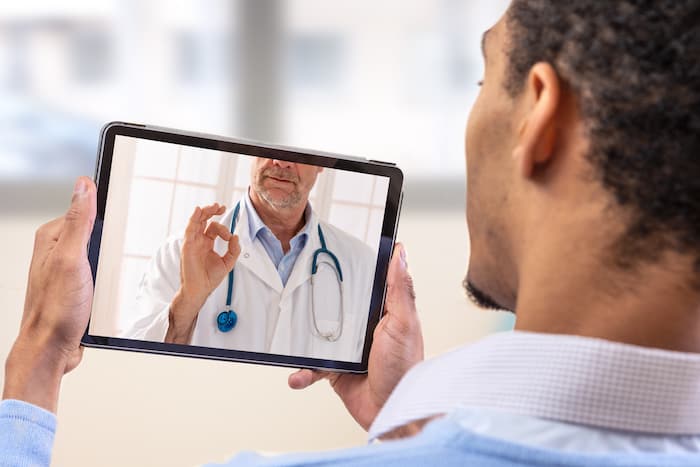By Michael Gorton, MS, JD
Currently, there is a large-scale push to make permanent some of the emergency policies related to telehealth access during the pandemic. Telehealth has enabled physicians to care for their patients during this difficult time of limited face-to-face contact, especially those in rural and medically underserved areas. Virtual care has become an integral part of care delivery and doctors are the latest group to press for making these changes permanent to keep the telehealth momentum going into the future.
The reality is that millions of Americans live in medically urban underserved areas and some 46 million Americans live in rural areas, which is 15 percent of the population. Together, they make up a substantial percentage of the American population who can benefit from telehealth because they experience these critical healthcare services shortages.
In fact, the Biden Administration recently allocated a small but vital $19 million investment in digital health to expand access to rural and medically underserved populations so they can receive better health services in primary care, acute care, and behavioral healthcare. Several telehealth initiatives will specifically help with complex conditions including long COVID and substance use disorder.
For starters, telehealth is helping rural and medically underserved communities tackle critical health issues because it can be accessed from anywhere and at any time, providing connectivity to a large network of healthcare professionals and serving patients no matter where they live or their circumstance.
Many now recognize that telehealth is becoming a first-line strategy to reach these patients, many of whom struggle with acute and chronic conditions and have compromised access to quality care.
Marginalized Populations Have a Lifeline with Behavioral Telehealth
Behavioral telehealth is playing a major role in providing access for treatment of mental/behavioral care and substance use disorders since it provides more options for convenience, privacy and safety than face-to-face meetings. In many cases, virtual consults have also been shown to be as effective as in-person visits.
Substance use disorders are a major problem in rural areas with alcohol as the most commonly used substance nationally. Rural young people are more likely than their urban peers to engage in risky alcohol-related behaviors, including binge drinking and driving under the influence of alcohol.
It is essential to manage these growing mental and behavioral health concerns because if left untreated, there can be additional or more serious chronic physical health problems.
With significant investments in behavioral telehealth there is a variety of services, including teletherapy and telehealth. There is individual teletherapy for one-on-one treatment and group teletherapy which offers added mental health benefits of community, reduced feelings of isolation and new perspectives.
Another significant, ongoing issue for rural residents is social isolation. A survey of 1,405 adults aged 18 or older living in the rural United States found that nearly one in five rural Americans say they always or often feel isolated or lonely. Behavioral telehealth is especially valuable in addressing social isolation because it creates a larger network of mental health providers which are in short supply and high demand.
A holistic behavioral telehealth solution like the one offered by Recuro Health provides individuals with confidentiality to access a wide variety of mental health treatments, including psychiatric care, psychosocial interventions, talk therapy and more, all in one place.
Telehealth Improves Health Outcomes
Telehealth can revolutionize the way healthcare providers can bridge the gap to make healthcare more accessible and improve outcomes for rural and medically underserved patients.
It also can remove barriers to care while reducing costs and burdens, including limited access to healthcare facilities, lack of transportation and childcare, lost work time, poor mobility for elderly and disabled patients and more.
With telehealth, patients can keep in better touch with their care providers, reducing the chance of a relapse in treatment and lower hospital readmission rates.
Remote Patient Monitoring (RPM), a type of home-based telehealth focused on capturing and sharing diagnostic information that can be especially impactful for rural residents and medically underserved populations. It enables all parties to monitor biometric and diagnostic measurements, avoid traveling long distances to the nearest provider or worry about long wait times.
The Best Digital Health Solution
The optimal digital health solution uses a digital medical home (add trademark) strategy like Recuro’s integrated, interoperable platform designed to house the tools, resources and support needed to manage a variety of health care issues and conditions in one place.
Recuro’s digital health solution is tailored so employers, payers and providers can build their own digital health platform with targeted solutions for certain populations, especially rural and medically underserved residents.
The best digital health solution can be fully integrated with existing solutions that may work with the curated suite of capabilities that Recuro offers, including virtual care/behavioral telehealth, at-home lab and onsite testing and genomics.
Michael Gorton, MS, JD, is the CEO and founder of Recuro Health and the Founding CEO and Chairman of Teladoc
Throughout the year, our writers feature fresh, in-depth, and relevant information for our audience of 40,000+ healthcare leaders and professionals. As a healthcare business publication, we cover and cherish our relationship with the entire health care industry including administrators, nurses, physicians, physical therapists, pharmacists, and more. We cover a broad spectrum from hospitals to medical offices to outpatient services to eye surgery centers to university settings. We focus on rehabilitation, nursing homes, home care, hospice as well as men’s health, women’s heath, and pediatrics.









1 thought on “Rural & Medically Underserved Communities Need Telehealth to Manage Critical Health Issues”
Comments are closed.